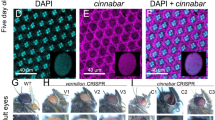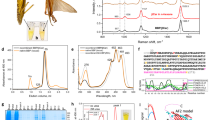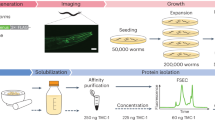Abstract
Hadorn and Mitchell1 demonstrated by simple chromatographic techniques the presence of two yellow, yellow-fluorescent compounds in Drosophila melanogaster. Both these compounds are accumulated in the sepia mutant, and one of them (F 1 5), which is by far the major component, has been isolated in crystalline form2. A structure has been postulated for it3, although this has had to be modified recently in the light of some new experiments on the compound to be described in this communication. The second component (F 1 7) is present in extremely small amounts even in the sepia mutant, and at such low levels it is very sensitive to light. However, we have succeeded in isolating a small amount of this material in crystalline form and have been able to demonstrate that it is indistinguishable from a yellow compound (compound A) which is found in comparatively large quantities in the blue-green alga, Anacystis nidulans 4,5.
This is a preview of subscription content, access via your institution
Access options
Subscribe to this journal
Receive 51 print issues and online access
$199.00 per year
only $3.90 per issue
Buy this article
- Purchase on Springer Link
- Instant access to full article PDF
Prices may be subject to local taxes which are calculated during checkout
Similar content being viewed by others
References
Hadorn, E., and Mitchell, H. K., Proc. U.S. Nat. Acad. Sci., 37, 650 (1951).
Forrest, H. S., and Mitchell, H. K., J. Amer. Chem. Soc., 76, 5656 (1954).
Forrest, H. S., and Mitchell, H. K., J. Amer. Chem. Soc., 76, 5658 (1954).
Forrest, H. S., Van Baalen, C., and Myers, J., Science, 125, 699 (1957).
Forrest, H. S., Van Baalen, C., and Myers, J. (unpublished work).
Aruga, H., Kawase, S., and Akino, M., Experientia, 10, 336 (1954).
Hama, T., and Obika, M., Experientia, 14, 182 (1958).
Forrest, H. S., and Hubby, J. (unpublished results). Viscontini, M., Hadorn, E., and Karrer, P., Helv. Chim. Acta, 40, 579 (1957).
Cf. Patterson, E. L., Milstrey, R., and Stokstad, E. L. R., J. Amer. Chem. Soc., 80, 2018 (1958).
Author information
Authors and Affiliations
Rights and permissions
About this article
Cite this article
FORREST, H., HATFIELD, D. & VAN BAALEN, C. Characterization of a Second Yellow Compound from Drosophila melanogaster . Nature 183, 1269–1270 (1959). https://doi.org/10.1038/1831269a0
Issue Date:
DOI: https://doi.org/10.1038/1831269a0
This article is cited by
-
Two new pteridinic pigments inDrosophila melanogaster
Experientia (1959)
Comments
By submitting a comment you agree to abide by our Terms and Community Guidelines. If you find something abusive or that does not comply with our terms or guidelines please flag it as inappropriate.



